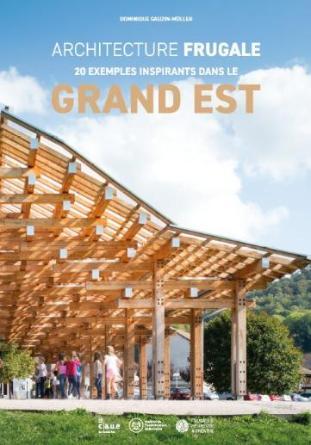Museum of the Clogmaker, Soucht, Moselle
Frugal architecture: 20 inspiring examples from the Grand Est
September 2021
FRUGALITÉ HEUREUSE et CREATIVE (FH&C)
There are already a large number of buildings that can be described as « frugal » and that demonstrate a new balance between tradition and modernity. This book highlights twenty projects recently built in the pioneering Grand Est region, whose local groups (in Lorraine and Alsace) are among the most committed. By sharing these inspiring examples, the intention of the Movement for Happy and Creative Frugality is to inspire professionals, decision-makers and citizens to get involved in the necessary paradigm shift, which is beginning to take shape.
New processes

Frugality aims at the decrease of materiality, but advocates the growth and blossoming of human relationships, in all their richness. The design of frugal buildings is often the subject of a participatory approach involving future users and even local residents. From the outset, it establishes a benevolent collaboration between all the players, from the project owner to the contractors, via the architects, the engineers of the design and control offices, etc. The Maison des enfants de Tendon, built from local beech wood, is a champion of short circuits. The Making Hof in Strasbourg symbolises the many facets of participatory housing and its advantages in creating social links between residents. As for the shoe-maker’s museum in Soucht, it was created by an association that wanted to preserve the memory of this Vosges know-how. The main thing is the human element, not the technology
« The initial ambition was to facilitate the appropriation of the place by the inhabitants and visitors. Today, young members of the association stimulate the life of the museum around contemporary design.
Pascal Demoulin Vosges du Nord Regional Nature Park
The Soucht clog factory fed hundreds of families for decades. To preserve its memory, a few old-timers have joined together to create a museum for schools and families. The building follows the relief to nestle between a humid valley and a wooded hill.

Access is on foot along the edge of an embankment, past a small square, a picnic area and the « Holzplatz », a log storage area used by children for climbing, jumping and swinging. Machines and tools are grouped together under the canopy, next to the mechanised workshop inside the museum. The folds of the copper roof follow the movements of the ground and define sub-spaces inside by reducing the partitions. Thanks to the reinforced insulation, the central stove, fuelled by logs or waste from the manufacture of clogs, is sufficient to heat the entire museum. By passing through the pipes of the Canadian well, the air is naturally preheated in winter, but also cooled in summer.
Laurence Moreau’s scenography takes visitors back to the daily life of the workers, presenting more than two hundred pairs of clogs from all over the world and tracing their manual and then mechanised manufacture. Visitors are immersed in a wooden cocoon: solid spruce panel facades, larch slat ceilings, varnished plywood furniture. Particular attention has been paid to the sensory dimension of the visit: the smell of wood, the sound of machines and simple handling.

Technical notebook
Location: Soucht, France
Year of construction: 2010
Surface area: 250 m2
Construction cost: 510.000 €.
Owner: Communauté des Communes du Pays de Bitche
Project management: Urbane Kultur, Dominique Cornaert
Sources
To go further
-
The book « Architecture frugale: 20 inspiring examples in the Grand Est » is available in full (in French) on the website of the Happy and Creative Frugality Movement.